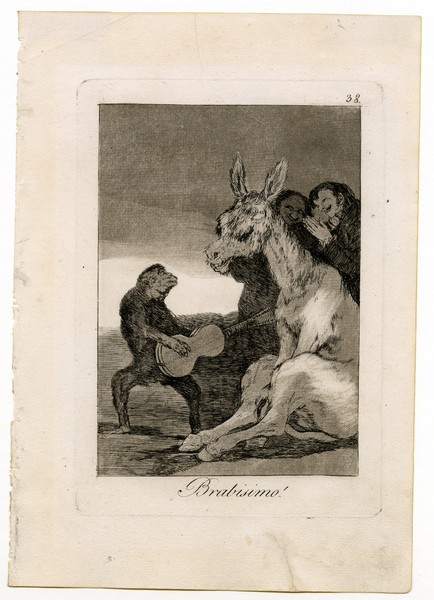- Cronología
- Ca. 1797 - 1799
- Dimensiones
- 215 x 150 mm
- Técnica y soporte
- Etching, burnished aquatint and drypoint
- Reconocimiento de la autoría de Goya
- Undisputed work
- Ficha: realización/revisión
- 13 Dec 2010 / 29 May 2024
- Inventario
- 225
Brabisimo! (at the bottom)
38. (in the upper right-hand corner)
See Francisco de Goya y Lucientes, Painter.
A proof before the letter presents three different inscriptions: one in sanguine that says Bravo; the second in ink that reads, Protege las Artes y dicen qe lo entiende, altered by se veque lo entiende; and a last one in black pencil, Protege las artes y se ve que lo entiende.
A preparatory drawing of this engraving is in the Prado Museum in Madrid.
A monkey plays a guitar upside down, i.e. on the side where the strings are not. In front of him sits a donkey who looks at him with an absorbed expression, who seems to be enjoying the recital offered by the ape. Behind him are two men applauding and laughing.
The title of the engraving is loaded with irony and serves to ridicule the donkey who is absorbed in a concert in which music is not present, as the monkey is not playing the guitar. Through this image, Goya lashes out at those who would have us believe that they enjoy music and boast of being great music lovers, when in reality they are absolute laymen. This idea is corroborated in three of the manuscripts in which Los Caprichos is explained. In the one in the National Library, for example, it is said that "even donkeys applaud bad music out of fashion, when they see others who say brabísimo".
In turn, this engraving has been interpreted as a veiled allusion to Charles IV and Maria Luisa of Parma, represented by the donkey, and to Manuel Godoy, who has been identified with the monkey, as the Prince of Peace gave private recitals to the kings in an attempt to win their favour.
This print continues the "donkeys" in The Caprices which Goya began in engraving no. 37, If the disciple knows better, and which concludes in no. 42, You who cannot.
The plate is preserved in the National Chalcography (no. 209).
-
El arte de GoyaMuseo de Arte Occidental de TokioTokyo1971from 16th 1971 to January 23th 1972. Exhibited also at the Kyoto Municipal Museum of Art, January 29th to March 15th 1972.cat. 70
-
Goya. Das Zeitalter der Revolucionen. Kunst um 1800 (1980 – 1981)Hamburger KunsthalleHamburg1980cat. 34
-
Goya. La década de Los CaprichosMadrid1992organized by Real Academia de Bellas Artes de San Fernando sponsored by Fundación Central Hispano, Madrid, consultant editor Nigel Glendinnig. From October 26th 1992 to January 10th 1993cat. 132
-
Francisco de GoyaMuseo d'Arte ModernaLugano1996exhibition celebrated from September 22nd to November 17th.cat. 38, p.65
-
Ydioma universal: Goya en la Biblioteca NacionalBiblioteca NacionalMadrid1996from September 19th to December 15th 1996cat. 134
-
Francisco Goya. Sein leben im spiegel der graphik. Fuendetodos 1746-1828 Bordeaux. 1746-1996Galerie KornfeldBern1996from November 21st 1996 to January 1997cat. 44
-
Goya e la tradizione italianaFondazione Magnani RoccaMamiano di Traversetolo (Parma)2006consultant editors Fred Licht and Simona Tosini Pizzetti. From September 9th to December 3th 2006cat. 38, p.155
-
Goya. Opera graficaPinacoteca del Castello di San GiorgioLegnano2006exhibition celebrated from December 16th 2006 to April 1st 2007p.33
-
Goya e ItaliaMuseo de ZaragozaZaragoza2008organized by the Fundación Goya en Aragóna, consultant editor Joan Sureda Pons. From June 1st to September 15th 2008cat. 327
-
Goya luces y sombrasCaixaForumBarcelona2012consultant editors José Manuel Matilla and Manuela B. Marqués. From March 16th to June 24th 2012cat. 32
-
Goya et la modernitéPinacothèque de ParisParís2013from October 11st 2013 to March 16th 2014cat. 143
-
Goya engravings and lithographs, vol. I y II.OxfordBruno Cassirer1964p.110, cat. 73
-
Vie et ouvre de Francisco de GoyaParísOffice du livre1970p.180, cat. 524
-
Goya, la década de los caprichos: dibujos y aguafuertesMadridReal Academia de Bellas Artes de San Fernando1992pp.217-220, cat. 221-223
-
Catálogo de las estampas de Goya en la Biblioteca NacionalMadridMinisterio de Educación y Cultura, Biblioteca Nacional1996p.94, cat. 127
-
El libro de los caprichos: dos siglos de interpretaciones (1799-1999). Catálogo de los dibujos, pruebas de estado, láminas de cobre y estampas de la primera ediciónMadridMuseo Nacional del Prado1999pp.216-219
-
ParísPinacoteca de París2013p. 205
-
Goya. In the Norton Simon MuseumPasadenaNorton Simon Museum2016pp. 42-75

